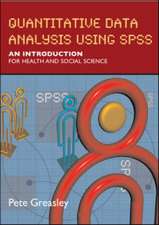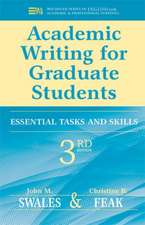Research Interviewing: The Range of Techniques
Autor Bill Gillhamen Limba Engleză Paperback – 16 aug 2005
* What techniques are used? Exactly what do you do in each technique?
* How is interview data analysed and written up?
The robust, real-world approach makes this book appropriate for practitioner researchers and postgraduate students up to PhD level. Covers distance and face-to-face interviewing, from the un-structured and naturalistic to the highly structured, focused and time-efficient.
Emphasis is placed on using the most appropriate methods for the research purpose and how to identify which method is practicable. Based on over thirty years of teaching and supervising research and postgraduate students, the author anticipates questions and difficulties at a level of practical detail. Practical and easy to use, this book is essential for anyone doing research interviewing.
Preț: 213.42 lei
Nou
Puncte Express: 320
Preț estimativ în valută:
40.84€ • 42.75$ • 33.79£
40.84€ • 42.75$ • 33.79£
Carte tipărită la comandă
Livrare economică 05-19 aprilie
Preluare comenzi: 021 569.72.76
Specificații
ISBN-13: 9780335215867
ISBN-10: 0335215866
Pagini: 200
Ilustrații: Illustrations
Dimensiuni: 166 x 235 x 13 mm
Greutate: 0.34 kg
Editura: McGraw Hill Education
Colecția Open University Press
Locul publicării:United Kingdom
ISBN-10: 0335215866
Pagini: 200
Ilustrații: Illustrations
Dimensiuni: 166 x 235 x 13 mm
Greutate: 0.34 kg
Editura: McGraw Hill Education
Colecția Open University Press
Locul publicării:United Kingdom
Cuprins
Preface
Acknowledgements
List of tables
List of figures
PART ONE: PRINCIPLES AND PRACTICE
1Research interviewing: key issues
2The ethics of interviewing
3The importance of question/topic development
4Different techniques and the ‘cost’ development factor
5The core skills of interviewing
PART TWO: FACE-TO-FACE METHODS
6Ethnographic methods: the interviewer as participant-observer in real-life contexts
7The unstructured interview
8The élite interview
9Group interviewing
10The semi-structured interview
11Structured interviewing: the use of recording schedules
12The video interview
13The interview as a qualitative experiment
PART THREE: DISTANCE METHODS
14The telephone interview
15The e-mail interview
16The ‘open’ questionnaire interview
PART FOUR: ANALYSIS AND INTERPRETATION OF CONTENT
17Transcribing the interview
18Narrative overview versus categorical analysis
19Deriving categories (coding) from the data
20Quantitative analysis of categorical data
21Writing up interview data
22Combining interview data with data from other sources
References
Index
List of tables
List of figures
PART ONE: PRINCIPLES AND PRACTICE
1Research interviewing: key issues
2The ethics of interviewing
3The importance of question/topic development
4Different techniques and the ‘cost’ development factor
5The core skills of interviewing
PART TWO: FACE-TO-FACE METHODS
6Ethnographic methods: the interviewer as participant-observer in real-life contexts
7The unstructured interview
8The élite interview
9Group interviewing
10The semi-structured interview
11Structured interviewing: the use of recording schedules
12The video interview
13The interview as a qualitative experiment
PART THREE: DISTANCE METHODS
14The telephone interview
15The e-mail interview
16The ‘open’ questionnaire interview
PART FOUR: ANALYSIS AND INTERPRETATION OF CONTENT
17Transcribing the interview
18Narrative overview versus categorical analysis
19Deriving categories (coding) from the data
20Quantitative analysis of categorical data
21Writing up interview data
22Combining interview data with data from other sources
References
Index















